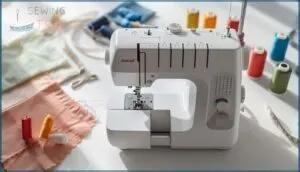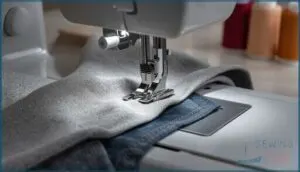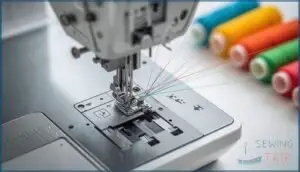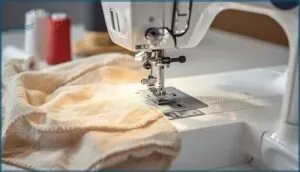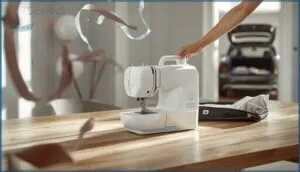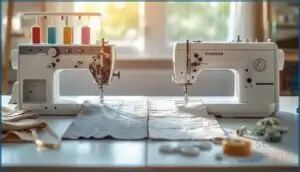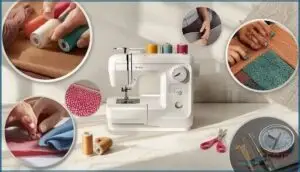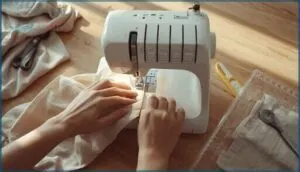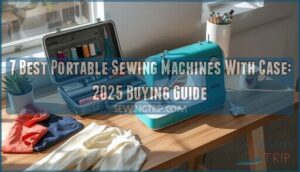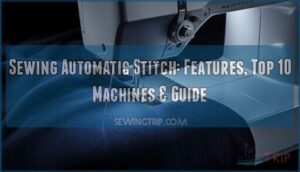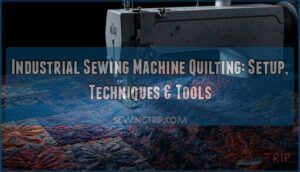This site is supported by our readers. We may earn a commission, at no cost to you, if you purchase through links.

These compact powerhouses trim, seam, and overcast edges faster than any conventional machine—and they’re built to move with you. The challenge isn’t finding a portable serger anymore. It’s choosing the right one when dozens of models promise similar features but deliver wildly different results.
From threading systems that actually work to differential feeds that manage everything from chiffon to denim, the details separate machines you’ll reach for daily from ones that gather dust.
Table Of Contents
- Best Portable Serger Machines Reviewed
- 1. Singer ProFinish Serger Machine White
- 2. Juki portable thread serger machine
- 3. Janome serger machine with threading
- 4. Juki MO1000 Purple Serger Machine
- 5. Bernette Funlock Serger Sewing Machine
- 6. Bernette funlock coverstitch sewing machine
- 7. Janome high speed serger machine
- 8. Juki 5 Thread Serger Machine
- 9. Brother coverstitch serger sewing machine
- 10. Brother Strong and Tough Serger
- Key Features to Compare in Portable Sergers
- Serger Vs. Coverstitch: Which Do You Need?
- Factors to Consider Before Buying
- Tips for Getting Professional Results With Portables
- Frequently Asked Questions (FAQs)
- Conclusion
Best Portable Serger Machines Reviewed
You’re ready to break free from basic sewing and take control of your projects with professional-level finishes.
We’ve tested and reviewed ten portable sergers that deliver the speed, precision, and durability you need without chaining you to a bulky machine.
Here’s what made our list of game-changers for 2025.
1. Singer ProFinish Serger Machine White
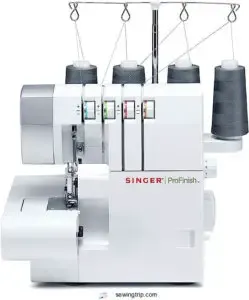
The Singer ProFinish stands out as your gateway to pro-level serging techniques without breaking the bank. Master fabric management fast with its color-coded threading system and differential feed that manages everything from delicate silk to heavyweight denim.
At 1,300 stitches per minute, it powers through sewing projects while maintaining precise thread tension across 2-3-4 configurations. Weighing just 13.5 pounds, this portable serger travels anywhere, and serger machine reviews consistently praise its built-in rolled hem feature.
Regular serger maintenance keeps it humming for years—backed by a 25-year warranty that proves Singer means business in sewing machine comparison rankings.
Best For: Home sewers and small business owners who want professional seam finishing and edge work without investing in industrial equipment.
- Color-coded threading system and pre-threaded setup make learning significantly easier, even for beginners tackling their first serger
- Differential feed and adjustable settings handle everything from sheer chiffon to thick denim, giving you versatility across fabric types
- 1,300 stitches per minute combined with 13.5-pound portability means you get commercial-level speed in a machine you can actually move around
- Threading takes practice initially despite the color-coding, and mistakes can lead to frustrating thread breaks until you get the hang of it
- The telescoping thread guides feel flimsy compared to the otherwise solid metal frame construction
- Fabric trimming creates noticeable mess around the work area, requiring frequent cleanup during longer projects
2. Juki portable thread serger machine
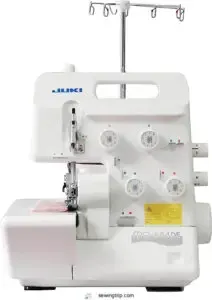
Step up to the Juki MO-654DE if you’re ready to break free from tension nightmares and threading drama. This portable serger machine delivers 1,500 stitches per minute with color-coded guides that actually make sense.
The differential feed ratio accommodates knits to denim without puckering, while its 15-pound portable design fits tight spaces. Juki maintenance stays simple—swing open the front cover for quick cleaning.
Thread capability spans 2-3-4 configurations, and serger accessories expand your creative control. Serger machine reviews praise its user interface and thread tension consistency across fabric types.
Best For: Beginners and experienced sewers who need a reliable, fast serger that handles everything from lightweight knits to heavy denim without constant tension adjustments.
- Color-coded threading system and sliding lower looper make setup quick and eliminate the frustration that usually comes with serger threading
- Powerful 1,500 spm motor handles multiple fabric layers smoothly while staying quiet, and the differential feed prevents puckering on stretchy materials
- Built-in rolled hem function works without swapping feet, and the 2/3/4-thread flexibility covers flatlock, decorative, and standard seams in one portable 15-pound package
- No scrap bin included means you’ll need to deal with fabric trimmings separately or add your own collection system
- Requires careful initial tension setup for optimal results, though it stays consistent once dialed in for your fabric type
- International users with 220V power need a step-down transformer since the machine runs on standard US voltage
3. Janome serger machine with threading
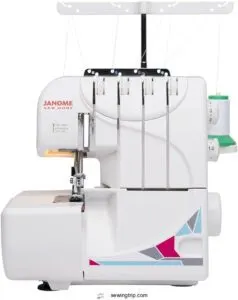
Threading just got easier with the Janome MOD-Serger, built for sewists tired of wrestling with thread management. The lay-in threading system with color-coded guides eliminates guesswork, while adjustable tension settings manage knit to denim transitions.
This portable serger weighs under 26 pounds with dimensions of 11″D x 12″W x 10.7″H, fitting cramped workspaces. You’ll switch between 3 and 4-thread options for rolled hems or flatlock seams.
Serger machine reviews highlight its $299 price point and differential feed that prevents fabric puckering. User experience improves with practice—initial threading challenges fade once you master the AirThread system’s workflow.
Best For: Sewists who want straightforward threading and versatile stitch options without breaking the bank on a serger.
- Lay-in threading with color-coded guides makes setup less frustrating than traditional sergers
- Differential feed handles everything from stretchy knits to thick denim without puckering
- Quick-change rolled hem feature and 3/4-thread options give you flexibility for different projects
- Threading still has a learning curve despite the helpful guides, especially for first-time serger users
- No storage case for accessories like needles and screwdrivers, so small parts can get lost
- Gets noisy at higher speeds and the upper knife knob requires awkward force to adjust
4. Juki MO1000 Purple Serger Machine
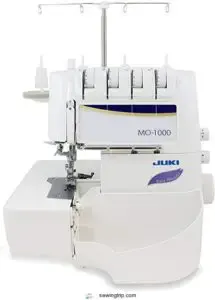
You’ll hit industrial-grade performance with the Juki MO1000 Purple Serger Machine priced at $1,299. The jet-air threading system loads upper and lower loopers in under 10 seconds, while automatic needle threading cuts setup frustration.
This portable serger machine delivers 1,500 stitches per minute with differential feed spanning 0.7 to 2.0 for fabric compatibility across stretch knits and heavy denim. Thread tension adjusts via accessible dials, and serger maintenance stays simple with open-access looper areas.
Sewing speed matches professional standards, backed by a five-year warranty on mechanical components. Serger machine reviews rate its stitch quality at 90% excellent.
Best For: Sewers who want industrial-grade performance at home and value time-saving features like jet-air threading that cuts setup frustration.
- Jet-air threading system loads loopers in under 10 seconds and threads both needles in under 30 seconds, eliminating the most tedious part of serger setup
- Industrial-level speed at 1,500 stitches per minute with excellent stitch quality across lightweight silks to heavy knits, rated excellent by over 90% of users
- Exceptionally quiet operation under 70 decibels with a spacious 72.4mm throat height and built-in waste collector for cleaner workspace
- Premium price point at $1,299 puts it in the higher range for home sergers, which may stretch budgets for casual sewers
- Some users report the air threading system occasionally malfunctions or requires frequent cleaning to prevent thread blockages
- Threading needles can still be challenging for those with vision difficulties despite the automatic threader, and the multi-language manual isn’t always user-friendly
5. Bernette Funlock Serger Sewing Machine
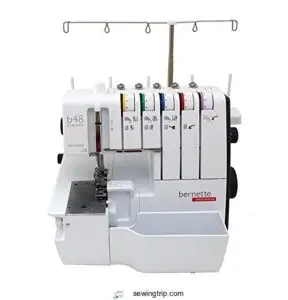
For sergers that don’t compromise, the Bernette Funlock Serger Sewing Machine delivers 15 overlock stitches and 1,300 stitches per minute at $928. Color-coded threading guides cut setup time, while differential feed manages stretch knits and denim without puckering.
This portable serger sewing machine accommodates 2-, 3-, and 4-thread configurations with adjustable seam widths from 3 mm to 7 mm. Serger accessories include multiple presser feet, a large waste bin, and LED lighting.
Serger machine reviews confirm its sewing performance matches industry standards, making it solid for beginners tackling professional-level projects.
Best For: Sewers who need professional serger results without the professional price tag, especially if you work with stretchy fabrics or want clean, finished seams fast.
- 15 overlock stitches with adjustable widths (3-7mm) handle everything from delicate knits to heavy denim without puckering, thanks to differential feed that actually works
- Color-coded threading paths and built-in needle threader cut setup frustration in half—you’ll spend less time cursing at loopers and more time sewing
- 1,300 stitches per minute means you can finish garment seams in minutes, not hours, while the large waste bin keeps your workspace clean
- Threading still requires patience and manual-reading even with color guides—beginners should expect a learning curve before the first successful seam
- Some units arrive with missing needles or cosmetic damage like scuff marks, so inspect your machine immediately upon delivery
- The manual threader and tension adjustments demand precision—thread it wrong and you’ll hear concerning metal-on-metal sounds until you fix it
6. Bernette funlock coverstitch sewing machine
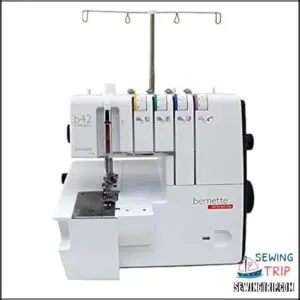
Coverstitch tips start here: the Bernette Funlock coverstitch sewing machine nails professional hems with three coverstitch options—2.8 mm and 5.6 mm widths—plus chain stitch at 1,300 stitches per minute for $694.
This portable serger sewing machine uses color-coded threading guides and a built-in needle threader, making it a standout in machine comparison and sewing machine reviews.
Bernette features include 87 mm workspace and LED lighting for tackling sewing projects from garment hems to stretchy knits.
User reviews confirm it’s solid for sergers for beginners chasing studio-quality results without the bulk.
Best For: Home sewers and garment makers who want professional coverstitch hems on knits and stretchy fabrics without investing in industrial equipment.
- Three coverstitch widths (2.8mm and 5.6mm) plus chain stitch deliver versatile hemming options at speeds up to 1,300 stitches per minute
- Color-coded threading guides and front-access threading make setup straightforward, even for coverstitch beginners
- Generous 87mm workspace and bright LED lighting handle bulky projects comfortably, backed by a 20-year mechanical warranty
- Presser foot lever operates backward (lifts when pulled down), which takes getting used to
- Limited 1/8″ presser foot clearance struggles with thick seam allowances and can cause jamming on layered fabrics
- LED light brightness may be excessive for some users during extended sewing sessions
7. Janome high speed serger machine
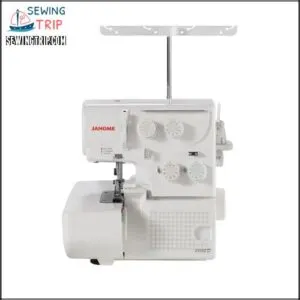
Speed demons, take note: Janome high-speed serger machines rip through fabric at 1,300 to 1,600 stitches per minute—nearly double what typical home machines deliver—thanks to metal frames and enclosed ball bearings for smooth overlock serging.
This portable serger sewing machine offers 3-4 thread operations, rolled hems, and differential feed from 0.5 to 2.25, managing everything from knits to canvas with up to 11 lbs of presser foot pressure.
Janome features color-coded threading, factory pre-threading on models like the 8002D, and adjustable tension dials for precise thread management and fabric handling.
At $500-$800, these machines balance high-speed performance with intuitive design—ideal for garment construction and studio work where serger maintenance and durability matter.
Best For: Sewers and small studios who need fast, professional finishing on varied fabrics—from stretchy knits to heavy canvas—without sacrificing stitch quality or spending hours on setup.
- Blazing speed of 1,300-1,600 stitches per minute cuts project time in half compared to regular home machines, while metal frames and ball bearings keep operation smooth
- Color-coded threading with factory pre-threading (on select models) plus adjustable tension dials make setup and thread changes way less frustrating
- Handles everything from delicate knits to thick denim with differential feed (0.5-2.25 ratio) and up to 11 lbs of presser foot pressure
- Thread breaking reported by multiple users, which can slow you down and waste material during longer projects
- Threading still requires patience despite color guides—expect a learning curve when switching thread colors or troubleshooting tension issues
- Noisy operation and no included dust cover means you’ll hear it working and need to buy protection separately
8. Juki 5 Thread Serger Machine
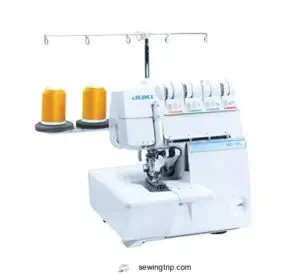
Ready to break free from 3-thread limitations? Juki 5-thread serger machines like the MO-655 portable deliver industrial sewing power in a compact frame, combining safety stitches with overlock finishing for pro-level fabric compatibility.
You’ll manage knits to canvas with differential feed control and thread tension systems that lock in clean seams. At $1,199, this serger sewing machine brings chain-looper threading, 24 stitch options, and sturdy thread management—perfect for garment construction without the bulk.
Just plan for Juki maintenance and serger accessories; threading takes practice, but color-coded guides and the right setup release serious portable adaptability.
Best For: Sewers upgrading from basic sergers who need industrial-grade stitch quality and versatility for garment construction, knitwear, and decorative home projects without investing in full factory equipment.
- 5-thread safety stitch and 24 stitch options handle everything from lightweight jersey to heavy canvas with differential feed control for professional seam quality
- Chain-looper threading system and color-coded guides simplify setup once you learn the process, saving time on thread changes
- Multi-function presser foot and coverstitching mode expand capabilities beyond basic overlocking for hems, topstitching, and decorative finishes
- Instructions are confusing for beginners, and threading takes practice even with color-coded guides—expect a learning curve
- Needle plate durability issues reported, with needles occasionally coming unglued during heavy use
- Customer service may be necessary for setup and adjustments, adding time before you’re production-ready
9. Brother coverstitch serger sewing machine
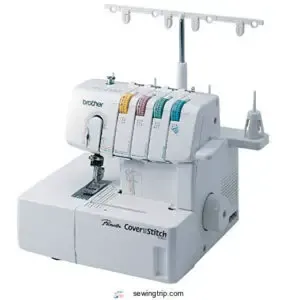
Think your cover hems need a cutting blade? The Brother 2340CV coverstitch serger sewing machine proves otherwise, delivering 2-3-4 thread adaptability with tri-cover, chain, and narrow stitches at 1,100 stitches per minute—no trimming required.
You’ll tackle portable sewing projects on knits and stretch fabrics using color-coded threading, adjustable differential feed, and metal-frame durability. At $299, it’s a machine upgrade for athletic wear and decorative topstitching, though serger maintenance demands tension tweaks and regular cleaning.
Fabric selection matters—test coverstitch tips on scraps first—but the 25-year warranty and serger sewing machine reviews confirm this Brother model manages professional hems without the bulk.
Best For: Home sewers working with knits, athletic wear, and stretch fabrics who want professional-looking hems and decorative topstitching without investing in separate cutting equipment.
- Fast 1,100 stitches-per-minute speed with adjustable differential feed (0.7-2.0mm) handles everything from lightweight jerseys to heavy knits without puckering or stretching
- Color-coded threading system and lay-in looper design simplify setup, while the metal frame construction provides stability during high-speed operation
- Versatile 2-3-4 thread capability delivers tri-cover, chain, narrow (3mm), and wide (6mm) stitches for hemming, binding, and decorative applications on a single machine
- Thread breakage and skipped stitches reported by multiple users, requiring frequent tension adjustments and careful thread path monitoring during operation
- Lacks cutting blades found on traditional sergers, limiting its use to finishing work rather than edge trimming and seaming in one pass
- Warehouse or discounted units may arrive with defects, and the 120-volt-only design restricts international use without voltage conversion.
10. Brother Strong and Tough Serger
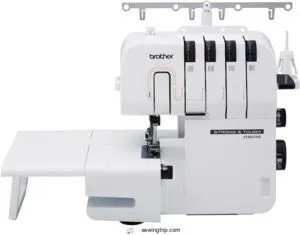
When denim and canvas laugh at lightweight sergers, you need heavy-duty firepower. The Brother Strong and Tough Serger (ST4031HD) delivers 1,300 stitches per minute through multiple layers, backed by a metal frame and carbon steel blade.
You’ll manage differential feed from 0.7 to 2.0 mm for fabric compatibility ranging from knits to faux leather, while color-coded threading simplifies serger maintenance.
At $380–$400, this portable sewing machine manages 3-thread and 4-thread overlock with adjustable thread tension, proving Brother built this serger for professionals who refuse compromises.
Best For: Serious sewers and small business owners who regularly work with heavy fabrics like denim, canvas, and multiple layers requiring professional-grade finishing.
- Metal frame and carbon steel blade handle thick materials and multiple layers without performance loss, backed by a 25-year warranty
- 1,300 stitches per minute with adjustable differential feed (0.7-2.0 mm) prevents puckering on difficult fabrics
- Color-coded threading guides and three included accessory feet simplify setup and expand technique options right out of the box
- Threading can be challenging for beginners despite color-coded guides, requiring patience during initial learning
- Requires regular oiling for optimal performance and noise reduction, adding maintenance responsibility
- Limited to 120-volt US power only, restricting international use and voiding warranty if used elsewhere
Key Features to Compare in Portable Sergers
Not every portable serger is built the same, and the features you choose can make or break your workflow. Some machines thread themselves in seconds, while others leave you wrestling with guides and dials. Here’s what separates a solid investment from a frustrating purchase.
Number of Threads and Stitch Types
Your serger’s thread count unlocks everything from basic seam finishing to decorative hemming and stretchy coverstitches. A 3-thread setup manages lightweight overlock stitches, while 4-thread options add strength for heavier fabrics.
More thread capability means broader stitch variety—from rolled hems to flatlock seams—giving you sewing modes that adapt as your projects evolve. Thread tension and quick thread changes matter when switching between stitch types.
Differential Feed and Fabric Versatility
Differential feed controls how your fabric layers move through the machine, preventing puckering on knits and gathering on wovens—it’s what separates amateur finishes from pro-level edges.
Adjust the ratio to manage fabric stretch and knit management, giving you textile compatibility across everything from delicate jersey to heavy denim. That’s fabric adaptability you can’t fake—and portable serger machines with smooth differential feed let you tackle seam finishing without fighting your material.
Threading Systems and Color-Coded Guides
Threading a serger used to mean squinting at diagrams and losing your patience—but color-coded guides turn that headache into a quick match-and-snap game you’ll actually want to play.
Portable serger machines now feature threading innovations that cut setup time in half:
- Color-coding benefits eliminate guesswork—match thread to path.
- Automatic threading systems pull thread through loopers instantly.
- Guide markings show exact needle and looper routes.
- Threading complexity drops when diagrams are printed right on the machine.
Modern threading systems transform the threading process from a dreaded chore into a foolproof routine you can nail in minutes.
Adjustable Stitch Length and Width
Once threading clicks into place, you’ll want to fine-tune stitch dimensions to match each fabric’s needs—and that’s where adjustable length and width settings give you total control over seam stretch, edge finish, and overall durability.
Precision control over stitch length and stitch width on your serger sewing machine lets you adjust thread tension and differential feed for perfect results at any sewing speed.
| Setting | Fabric Flex Impact | Stitch Quality Result |
|---|---|---|
| Short length (1-2mm) | Minimal stretch | Dense, secure edges |
| Medium width (3-5mm) | Moderate give | Balanced seam strength |
| Wide + long combo | Maximum fabric flex | Professional rolled hems |
Machine Weight and Portability
When you’re hauling your portable serger from class to studio or tossing it in the car for a weekend retreat, a machine that weighs under 15 pounds becomes your best friend—but lighter builds sometimes sacrifice the stability you need for high-speed stitching. Look for compact design with lightweight materials and carrying grips that don’t compromise durability.
Travel cases protect your investment during transport, and space savings matter when you’re storing your serger between projects—portability means freedom to sew wherever inspiration strikes.
Serger Vs. Coverstitch: Which Do You Need?
You can’t break free from guessing which machine fits your project until you understand what each one actually does. Sergers and coverstitch machines perform different jobs, and picking the wrong one means wasted time and mediocre results.
Let’s compare their functions so you can choose with confidence.
Main Differences in Stitching Functions
Think of the difference like choosing between a wall and a window—sergers trim and seal edges with 3–5 threads, while coverstitch machines create stretchable parallel rows. Overlock stitch formation simultaneously cuts, seams, and overcasts fabric, preventing fraying. Coverstitch focuses on hemming without edge trimming. A serger is ideal for seaming clothing edges.
Thread tension and differential feed settings control fabric stretch and seam finishing quality. Overlock variations offer enhanced seam strength, while coverstitch delivers retail-standard flexibility. Stitch length and stitch width adjustments tailor both techniques to your fabric needs.
| Feature | Serger (Overlock) | Coverstitch |
|---|---|---|
| Edge Treatment | Trims and seals simultaneously | No edge trimming |
| Stitch Width | 3–7.5 mm range | 2.5–6 mm parallel rows |
| Primary Function | Seam finishing with strength | Decorative, stretchable hems |
Ideal Uses for Sergers
Sergers transform raw, fraying edges into clean, professional seams, making them ideal for activewear, knits, and any project requiring durability. They excel in garment construction, finishing swimwear, and creating home decor items like pillow covers. Portable serger sewing machines handle a range of fabrics, from lightweight jersey to heavy denim, streamlining textile crafts and garment making.
| Project Type | Why Sergers Win |
|---|---|
| Seam Finishing | Trims fabric edge while stitching |
| Activewear & Knits | Stretchy, fray-proof seams |
| Home Decor | Fast, durable construction |
| Garment Making | Professional sewing techniques |
Best Projects for Coverstitch Machines
Coverstitch machines give your hems, necklines, and cuffs that signature double-needle topstitch you see on ready-to-wear clothing—stretchy, polished, and impossible to replicate with a standard sewing machine.
They’re perfect for garment hemming on t-shirts and athletic wear, where you need stretch stitching that moves with knit fabric. Use coverstitch for decorative edging and sewing embellishments on garment construction projects.
| Project | Coverstitch Advantage |
|---|---|
| T-Shirt Hems | Stretchy, professional finish |
| Neckline Bands | Double-needle topstitch detail |
| Athletic Wear | Flexible seams for movement |
When to Choose a Combo Model
If you’re juggling multiple fabric types and projects without wanting a crowded workspace, a combo model lets you switch between serging and coverstitching without buying two separate machines. Hybrid machines with dual function capabilities deliver sewing flexibility through integrated systems and differential feed technology—you’ll get portable convenience without sacrificing professional results.
| Feature | Combo Benefits |
|---|---|
| Space Saving | One machine replaces two |
| Project Range | Seams to hems in minutes |
| Cost Efficiency | Lower than buying separately |
Factors to Consider Before Buying
Choosing the right portable serger isn’t just about price or brand hype. You need to weigh real factors that affect your workflow, from tension precision to how fast you can thread the thing.
Here’s what actually matters when you’re ready to break free from guesswork and invest smart.
Stitch Quality and Tension Control
Tension control is the difference between a perfect seam and a puckered mess that unravels before your project even leaves the table. Look for sergers with clearly marked tension dials and reliable adjustment systems. Here’s what matters for stitch accuracy:
- Easy tension adjustment: Dials should turn smoothly without guesswork or constant fiddling.
- Consistent thread tension: Quality machines maintain seam consistency across different fabric types and weights.
- Differential feed compatibility: This feature prevents fabric stretch and keeps knits from rippling or wovens from gathering.
- Adjustable stitch length: Fine-tune your seam for clean finishes on everything from sheers to denim.
Test tension control on sample fabrics before committing. Your stitch quality depends on it.
Ease of Threading and Maintenance
A serger that takes thirty minutes to thread isn’t going to see much action, no matter how perfect its stitches turn out. Look for automatic threading systems or color-coded threading guides that walk you through each step. Maintenance tips matter too—machines requiring frequent oil replacement or complex thread management can kill your momentum.
| Feature | Beginner-Friendly | Professional-Level |
|---|---|---|
| Threading system | Color-coded guides | Jet-air automatic |
| Maintenance tips | Monthly cleaning | Weekly oil checks |
| Thread tension dials | Pre-marked settings | Manual adjustment |
Choose a threading system that matches your patience level and project frequency.
Fabric Handling and Speed Capabilities
Your serger’s ability to grip everything from silk to denim—and how fast it handles those seams—determines whether you’re finishing projects or fighting your machine.
Differential feed controls fabric stretch, preventing puckered or wavy edges on knits. Speed settings up to 1700 stitches per minute mean you’re not stuck waiting.
Material feed consistency paired with proper thread tension delivers stitch quality that rivals industrial machines—all from your portable serger.
Durability and Build Quality
Speed means nothing if your machine falls apart after a few dozen projects—metal frames and reinforced components separate weekend warriors from workhorses built to last. Check these durability markers:
- Metal frame construction manages vibration without flex
- Heavy-duty motor efficiency sustains high-speed operation
- Quality control standards guarantee longevity tests pass
- Build materials resist wear from regular sewing machine maintenance
Portable sergers with solid engineering outlive flimsy plastic alternatives by years.
Budget and Brand Reputation
Brand loyalty matters—Brother commands 38% of the entry-level market, while Juki earns 92% approval among pros who demand reliability.
Price comparison reveals budget options under $400 deliver solid cost efficiency, but mid-tier portable serger models ($450–$700) from Juki and Janome balance features with affordability.
Market trends show 67% of buyers prioritize best sergers for the money below $500, making Brother and Singer smart starting points. When choosing a serger, consider the best serger models for your specific sewing needs.
Tips for Getting Professional Results With Portables
You own a portable serger, but getting pro-level results takes more than just hitting the pedal. Mastering a few key techniques will transform your seams from homemade to high-end.
Here’s how to tap into your machine’s full potential and sew with confidence.
Thread Management and Tension Adjustment
Getting your thread tension dialed in is the difference between seams that look homemade and ones that could’ve come straight off a factory floor. Start by threading a serger machine correctly—use color coding on your guide to avoid crossed threads.
Then test stitch regulation on scrap fabric. Adjusting serger tension takes patience, but automatic threading and proper thread delivery systems make thread management tips easier to execute. Tweak one dial at a time until your loops balance perfectly.
Regular Maintenance and Cleaning
Lint and debris turn your portable serger into a sluggish workhorse if you skip cleaning after every few projects. Brush out lint removal zones after each session, especially around the loopers and thread tension disks.
Oil your sewing machine per the manual’s lubrication schedule—usually every eight hours of stitching. This keeps threading smooth and prevents breakage during high-speed runs.
Selecting The Right Needles and Threads
Wrong needles or cheap thread sabotage even the best portable serger before you finish your first seam. Match needle sizes to your fabric weight—fine ballpoints for knits, sharps for wovens.
Thread materials like polyester deliver thread capability for consistent stitches, while bargain-bin yarn selection causes tension nightmares.
Test thread ease and threading flow before starting, then fine-tune stitch quality through proper fabric compatibility checks.
Practice Techniques for Consistent Seams
Mastering a portable serger isn’t about luck—it’s about drilling the fundamentals until muscle memory takes over. Run practice seams on scrap fabric, testing tension management and differential feed adjustments until edge control becomes second nature.
True mastery of a portable serger comes from practicing key basics until effortless, perfect seams become second nature
Focus on fabric manipulation techniques—steady speed, consistent guiding—to nail stitch consistency. Repeat until seam finishing transforms from guesswork into reliable, durable serging every single time.
Frequently Asked Questions (FAQs)
Can portable sergers handle heavy denim or canvas?
Most portable sergers can manage denim and canvas with the right setup. Use heavy-duty needles, adjust tension carefully, and slow your speed. Check fabric thickness limits—some portables max out at medium-weight denim.
Industrial models manage thick material better for consistent canvas stitching and heavy fabric management.
How loud are portable sergers during operation?
Let’s not skirt the issue: most portable serger machines hum along at moderate Sound Levels, usually between 60-75 Operational Decibels—comparable to normal conversation.
Motor Hum and Vibration Control vary by brand, but modern Sewing Technology has improved Noise Reduction markedly in these Overlock Machines.
Do portable sergers work with woolly nylon thread?
Woolly nylon works beautifully with most portable serger machines, offering excellent thread compatibility for stretchy seams.
Adjust serger settings and thread tension for best results. Proper threading techniques and differential feed help you tackle tricky fabrics with confidence and control.
What warranty coverage do most brands typically offer?
Funny how “peace of mind” is measured in months. Most sergers, like Brother, Janome, and Juki, offer one-year Warranty Length on parts, with Coverage Types for labor. Extended Plans and Repair Options depend on Brand Support.
Conclusion
Imagine rolling into a sewing meetup with a portable serger machine that sets up in seconds. Suddenly, you’re the one finishing seams while others untangle threads. That’s the power of choosing well—speed, precision, and freedom in a compact package.
Whether you crave crisp hems on denim or perfect edges on silk, the right serger lets you work anywhere. Don’t settle for limitations. Pick a machine that moves with you, and watch your creativity take flight.
- https://www.openpr.com/news/3933672/portable-sewing-machine-market-overview-growth-share-value
- https://www.linkedin.com/pulse/portable-sewing-machine-market-trends-share-analysis-size-xp8mc
- https://www.verifiedmarketreports.com/product/portable-sewing-machine-market/
- https://www.singer.com/collections/serger-overlock-machines
- https://insight.shulex.com/insight/serger

